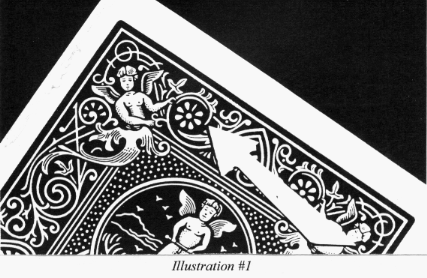Part Four : Paper, Gaffs and Gadgets
When the average layman thinks of cheating at a card game, the first idea that usually comes to mind is some form of marked cards.In the world of cheaters, marked or gaffed cards are known as "paper". Paper is the tool of choice mainly amongst amateur cheats however mainly because they are easy to use and require no skill or practice. This is not to say that a professional cheat would never make use of marked cards, but most would prefer to use sleight of hand techniques. The reason is simple; if they are suspected of cheating, the first thing the accusers will check are the cards. If the cheat has been using exclusively sleight of hand techniques, there will be no evidence left behind. Marked cards could endanger his health. Also, most pros work on the road, playing with strangers and then moving on before someone catches on. People are quick to suspect the stranger of cheating if they are losing their money to him. On the other hand however, an amateur cheater is more likely to run a "still" game. That is, a game held on a regular basis where most of the players know each other and, for the most part, trust each other. These are actually the games that marked or gaffed cards will show up.
 | ||||||
A. Marked Cards (marked before the game)
Just because a player brings a brand new looking deck to your game (complete with an unbroken seal on top), don't be too sure that these cards have not been tampered with. Novelty stores and web sites sell marked decks that are sealed. If a cheater wants to mark them himself, all he has to do is carefully open the cellophane wrapper at the bottom using a razor knife and then open the side of the box. After marking the cards, the deck can be sealed back up just like new with a little glue.
 | ||||||
1. Blockouts - Cheats can mark cards with aniline dye that has been precisely color matched. Cards with pictures on the back design, let's say of birds for instance, can be colored over or "blocked out") to denote the card value. If there are seven birds on the original back and the middle one is blocked out, this could denote an ace. The second on the right is a king etc. Only someone looking very hard for marks will likely notice. Cards with a diamond back design can have one edge of a specific diamond increased slightly. The row of diamonds chosen will denote the card value (aces are usually marked near the top and bottom edges while lower cards towards the middle) and the side of the diamond that is increased can denote the suit (top left clubs, top right diamonds etc.). An easy way to check the cards for such markings is to riffle the deck face down in front of you and look for jumpy animated looking movements in the back design.
2. White on White - Cards that have a white border on the back can be marked with a little bit of "white out" or white fingernail pencils. These marks can also be placed in positions that denote the rank of the cards and can only be visible when the light shines over them from the correct angle. The tops and of course bottoms can also have small markings to represent suits.
3. Flashwork - This is a technique of darkening the back of diamond-back cards ever so slightly using a charcoal pencil, all but a row of diamonds at both ends. The position of the unshaded row represents the value of the card (again, usually aces near the edges and the lowest cards near the middle). Viewing flashwork close-up is rather difficult while at a distance (as the cards are being dealt across the table) they can be spotted by a cheat who knows exactly what he is looking for. It is said that cheats who use flashwork often have to unfocus their eyes slightly to read the cards as they are dealt.
4. Luminous Readers - At one time, these were a joke amongst cheaters, but today, I think they should be taken more seriously. "Luminous Readers" as they are called, are any brand of cards with a red back design that have been marked with an emerald green daub. The daub is virtually invisible (and available at many "magic" shops) unless viewed through a red lens. When this gimmick originally appeared, red-lensed glasses were practically unheard of, and a cheater would have been laughed out of any card game if he showed up wearing them. Even if the players at the game didn't know what "luminous readers" were, they would have to suspect something was going on. The public seemed well aware of them in the 1970's as comic books and gift shops advertised them. Today, color tinted "shades" are common, as are red contact lenses, but uncommon seems the knowledge of luminous readers. The easy thing about the daub is that is can be applied with the finger tips at the game (in fact, sometimes it is sold in a button shaped dispenser that you can sew on to your clothes, un-cap the button and apply) in very subtle smudges to denote ranks of cards, or done at home in very blatant large lettering. I have seen some that had "JS" (for example) in large letters to denote the Jack of Spades. It was thoroughly invisible until I put the glasses on though. If you have ever been in a casino, you may have noticed that all the cards played in a game go into a plastic discard holder until they are reshuffled. These discard holders are always red and translucent to allow supervisors and cameras to ensure that this gimmick has not been used. The casino that I work at recently switched their card back designs to yellow and green, probably to further protect themselves from this form of cheating.
B. Marked Cards (during the game)
1. Waves - Putting a wave into your average (plastic coated paper) playing card is easy. Simply bending and sliding a card on the table leaves a "wavy" effect on the card for quite some time (many times permanently). The wave can be intended to denote the strength or color of the card. Cards waved inward or outward depending on the cheater's preference. Euchre is a game where waved cards serve little purpose unless they are denoting the colors black or red in conjunction with a system of marking that denotes the suits. Some players may wave black suits inward and red suits outward while using a nail-nick or some other technique to denote the rank. It is easily noticed when the hand is lying flat on a table, in fact too easily. The cheat usually looks to see the curved shadows between the cards of his opponents fanned-out hands to determine if he will likely bid on a color, black or red. The cheat will constantly be at work putting waves on the cards until they have all passed through his hands.
2. Nail-Nicks - A very popular form of marking cards. The cheat picks the spot on the card while spreading out his hand to look at them, he squeezes his thumbnail into the card while pinching back with index finger. This leaves a little nick in the card that can be spotted if it is being looked for. Once again, the location of the nick is usually indicative of the value of the card.
3.Knock-Offs - If a player wants to know where certain cards are, let's say the jacks for instance, he can glue a small strip of sandpaper to the tip of his middle finger. The old timers call this a "knock-off stick". As he looks at his cards, he applies some of the sandpaper to the edge of all the jacks that he runs across. He can make it appear that he is shuffling his cards over and over in his hand. Every time the jack goes through, the middle fingertip scrapes the edge. By sanding the side of the card, it will become easily visible to the cheater while it is in the other player's hands. When the light hits it, the sanded edge wil appear a little more shiny than the other cards. It will go largely unnoticed by the other players most of the time.
4. Blisters - Some cheats carry a little device known as a "pegger" that pinches the cards in a manner that a little "blister" is left in the appropriate spot. Blisters are not used as a visual marking, but actually more like braille is used for the blind. When the cheat deals, he can feel the blisters and shuffle the cards into beneficial positions. The blisters are subtle enough to go unnoticed to the other players. If you don't leave the cheat alone with your deck too long, you might never have to run up against this gimmick.
C. Trims and Strippers
Not quite what you might be thinking about when you first hear these terms.
Anyone who has ever owned a "Svengali" magic deck knows exactly what these are. Simply put, some cards are slightly bigger than others, making them easy to locate. In euchre, a deck of "jack strippers" would be prepared by trimming 1/32 of an inch off the top, bottom and both sides of the cards in the deck except the jacks. The corners would then be rounded off using a corner cutter that is available at most arts and craft shops for making scrapbooks etc. This leaves the jacks slightly larger than the rest of the cards in the deck making it child's play finding them (but only if you know what you are looking for). One hand holds the deck in place while the other slides the index finger and thumb across the deck, stripping out the thicker cards. This feature is obviously useful for stacking the deck.
Some steps for keeping your equipment safe:
1. Keep the cards you plan to use in your tournament locked up.
2. It's best to avoid brands of cards available at every drug store in town. Consider investing in all-plastic cards (Kem etc.). They outlast regular plastic coated paper cards by about five years and are harder to mark, and nearly impossible to wave.
3. Check your cards carefully before the game and then after. Spread them face down and check the back design on each card carefully. Let the light glare over them from different angles. Look closely for nail-nicks, creases and feel them for blisters. Finding some obvious marks after a game may be a red flag that you have allowed a cheat into your game.
4. If you play someone else's tournament, check their cards in the manner mentioned above yourself. Also, riffle the deck and look for jumpy "animations" on the back design. Note that strippers will rattle inside their box when shaken and a look at them from the side of the deck will appear jagged (especially the appearance of the back design).
Also note: Don't play a money game with worn out cards. Naturally occurring blemishes and damage can easily be memorized by a player who didn't even intend to cheat you.
NEXT:





Notice the flower petals. Back
Note : two diamonds have been connected. Back
Close-up
Close-up